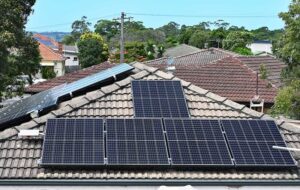Notwithstanding the impacts of heatwaves in southern Australia during January, total annual NEM generation, and associated emissions, both fell compared with the year ending December 2013, although only slightly (Figure 1).
An increase in demand in Victoria and a very small increase in SA were offset by small reductions in NSW and Queensland (Figure 2). The very marginal changes in demand were matched by similarly small changes in the mix of electricity generation (Figure 3).
Wind generation increased on an annual basis for the simple reason that three new windfarms were commissioned during the year, so that total installed capacity was about 420 MW greater than in January 2013. Supply from all other sources was either unchanged or showed a slight fall. Several aspects of how the NEM operated during January merit further discussion.
Starting with Victorian and South Australian demand for electricity, the increases were undoubtedly caused by the hotter weather in January 2014, compared to January 2013. Electricity demand during summer in both states is characterised by extreme peakiness, with electricity demand on one day much like another if maximum temperature is below about 30 deg. C, but rising sharply with higher temperatures.
In Melbourne in January 2014 maxima were above 30 on nine days, for which the average maximum was 38.7 deg. C. In January 2013 there were seven above 30 days, with an average of 36.5 deg. C. Moreover, in January 2014 there was a run of five 30 deg. C plus days (January 13 to 17), of which all but the first had maxima well above 40 deg. C.
The electricity supply industry has long recognised that long runs of extremely hot days cause higher daily demand by the end of the run than a single isolated extremely hot day, even if the single day is hotter than any of the run of days. There were no runs of very hot days in January 2013. The differences between January 2014 and January 2013 were similar in Adelaide, but with more very hot days in each year and higher average maxima, reflecting the climate difference from Melbourne.
Given the high number of very hot days in January 2014, compared with the previous year, it is not surprising that electricity demand was higher in 2014; the surprise is that the increase in demand was so slight. The modest nature of the increase can be attributed to two factors.
Firstly, overall residential electricity demand, which is a major driver of hot weather peaks, has been steadily falling for some years. In the last week of January, the Australian Bureau of Statistics completed its release of its Business Survey of Residential Electricity Distribution (Cat. No. 4670.0). These data, accessed from electricity distributors by the ABS, are in effect a census of annual residential electricity meter readings for the 2010, 2011 and 2012 calendar years.
They show that national average annual electricity consumption per meter, i.e. per household, fell by 11% over the two years 2010 to 2012. Total residential electricity demand, allowing for the growth in customer numbers, fell by 9%. These falls were remarkably uniform across all states, and all the available data suggest that they continued throughout 2013.
There are two significant effects on peak. The reduction in average residential electricity consumption in January 2014, compared with January 2013, at all times outside the extreme peaks on very hot days, lessens the impact of more extremely hot days on total demand. Additionally the effect on the specific energy use that drives the peaks themselves should not be ignored.
A significant contribution to the overall decrease in residential electricity consumption can be attributed to the greatly improved efficiency of refrigerators and small air conditioners. This flows through to smaller peaks as improved efficiency means that more cooling can be achieved with less electricity consumption, even when the requirement for cooling is very large.
Secondly, demand for electricity in the NEM excludes electricity supplied by rooftop photovoltaic (PV) panels. Total capacity continued to grow strongly throughout 2013 in both Victoria and SA, and so contributed to limiting the increase in total demand in each state in January 2014, compared with January 2013.
Rooftop PV was even more important during the extreme heat days of 14 to 17 January, when both Melbourne and Adelaide experienced four successive days with maximum temperatures above 40 deg. C. At no time during this period in either Victoria or SA was the historic peak in demand exceeded, notwithstanding similar weather and more consumers than in 2009 (the Victorian peak) and in 2011 (the SA peak).
Analysis just released by AEMO shows that in both states demand on the NEM (what AEMO calls operational demand) would have been about 100 MW higher in the absence PV. In SA it would also have been at least one hour earlier in the afternoon, closer to the time of peak Victorian demand. At maximum output, in the early afternoon, PV supplied about 300 MW equal to 10% of total electricity consumption on 16 January, the day when both temperature and peak demand reached their highest for the week.
Some quarters of the electricity industry have suggested that more open cycle gas turbine (OCGT) generation is required to deal with the problem of peak. A couple of observations on this are pertinent. Firstly, only for one hour on the afternoon of 15 January did the combined available OCGT capacity across Victoria and SA begin to approach full utilization.
Secondly, a far more cost effective approach would be to build upon the success of energy efficiency programs, requiring network businesses to use the technical capability for direct load control which is now required to be included in all new residential air conditioners and swimming pool pumps. This approach is already being taken up by electricity network businesses in parts of the USA and in New Zealand.
The experience of the mid‐January heat wave showed that the rapid growth in rooftop PV, combined with more efficient of household air conditioners and refrigerators, has ensured that there was always sufficient electricity available to meet the demands of electricity consumers.
Perhaps just as importantly, it appears that the massive upgrades in network capacity over the last few years, which made such a large contribution to higher retail electricity prices, appear to have ensured that networks were able to meet the demand and load shedding was not required.













